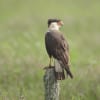 By Jim Stevenson
By Jim Stevenson
We still have a couple places on our Spring Songbird (4-day) weekend April 24-27. Small group (we also do shorebirds in full breeding regalia), and tour the UTC, returning home each night (or you can get a hotel). This is the height of the spring migration, by far the best time for shorebirds, baby spoonbills are out and most of our rare visitors are seen then.
Your gallery is on Primitive Land Birds:
Our songbirds are largely rather advanced birds, found in the field guides from flycatchers to the end, but we also have many other (smaller) orders of terrestrial species which are more primitive, and quite interesting. They tend not to have the bright colors of songbirds (Passeriformes), most don’t sing, most also cannot orient while migrating as well as many songbirds and there are other lesser reasons to consider them somewhat less advanced. Here is a gallery on some of our representative orders of more primitive land birds.
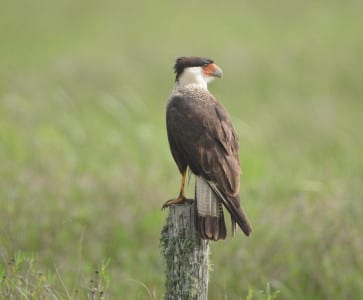
Early spring is a great time to be watching for changes in birds’ plumages. This Crested
Caracara is morphing from the brown-backed immature bird to the black-backed adult.
Birds reach their adult size in around six weeks, but often it is a year or more before they
attain their breeding colors. With some groups like hawks and gulls, it can be quite a
challenge to get a handle on all the ages, races and both sexes.
![Great Horned Owls are fairly common in more open areas of North America, actually ranging down to the tip of South America. This one and her mate nested in my east Palm Tree this winter, running out the caracara pair that used it last year. [Cool yard, no?] Her voice is deeper than his, but I’ll leave the “wise” part for the cartoons. This species in the West is quite a bit grayer than these reddish eastern birds.](https://www.crystalbeachlocalnews.com/wp-content/uploads/2014/04/Primitive-Land-Birds-2-302x300.jpg)
Great Horned Owls are fairly common in more open areas of North America, actually
ranging down to the tip of South America. This one and her mate nested in my east Palm
Tree this winter, running out the caracara pair that used it last year. [Cool yard, no?] Her
voice is deeper than his, but I’ll leave the “wise” part for the cartoons. This species in the
West is quite a bit grayer than these reddish eastern birds.
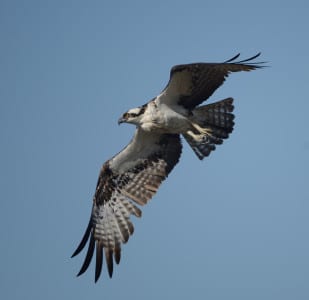
One of our few circum-Equatorial birds is the Osprey, the only species in an entire
family. If those toes seem a little long, [don ’t try clipping them!) they are exaggerated for
piercing the dorsal epidermal and vertebral layers of fish. While some great birds of prey
(eagles) will fly off when their nests are approached by humans, Ospreys will rip off your
arms to the nub.
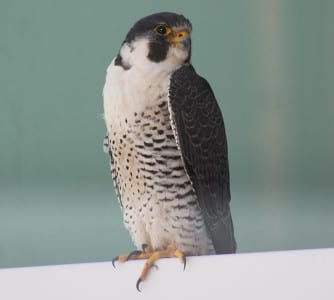
The most widespread of the falcons is our Peregr ine, and this one was photographed by
our local Audubon President, who works there at Moody Gardens. Great shot! Peregrines
are among our fastest birds, diving on hapless birds at speeds in excess of one hundred
mph (or about what I drive on the Seawall). Their range extends across the Planet, with
the exception of Antarctica. Hot bird! :0
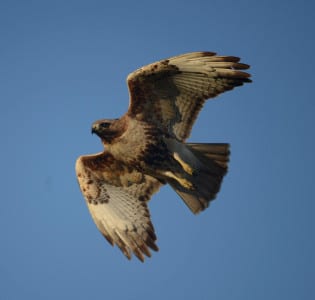
Quite the successful species is the Red-tailed Hawk, with the dark head and belly band
being useful in IDing immatures like this one. Once we stopped using DDT this species
became very common and widespread in America (once again), and is a huge fr iend to
farmers whose rats portion off considerable sections of crops.
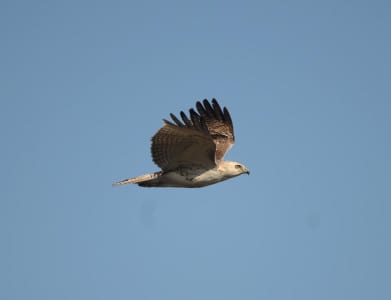
We get a fair number of wintering red-tails in the B. j. krideri race, very pale (and quite
frankly even more wary!). This bird wintered over near Anahuac NWR and my friend
David prolly took about ten thousand pictures of it! There is a movement gaining traction
to separate these krideri into another species with harlani (of Alaska), who would be the
dark form. I’ve read some of the preliminary work and it seems plausible.
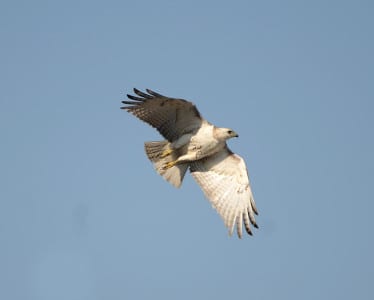
Here’s a little lighter one, and I suspect a smaller male. Female hawks (and sandpipers)
are larger than their male counterparts, with few exceptions. This allows two feeding
niches, although there must be a lot of crossover. And I’ll bet I know who wears the pants
in that family!
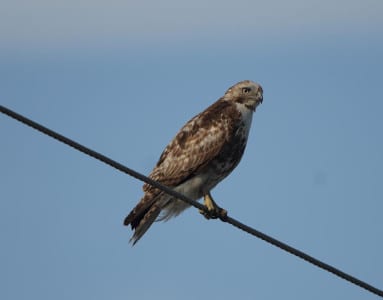
Here is a more normal immature red-tail, with a broad belly band and worn plumage. We
get mostly young birds after February as the adults have gone north to begin nesting and
rearing. Probably due to the cold winter, many birds were late clearing out (I mentioned
the cranes earlier), and we even had kestrels well into April.
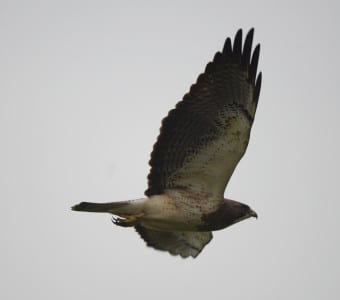
Swainson’s Hawks migrate from the Great Plains to southern South America, on the
Pampas of Argentina. A few of the more eastern birds pass through the UTC and this bird
was over on Bolivar. Bad sky for a picture. With the long migration of several thousand
miles, they have reduced bills and feet to save energy.
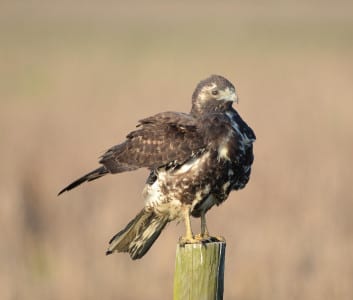
Another bird that ranges well into South America but not as a migrant is the White-tailed
Hawk. These juveniles are quite unlike the eventual adult, and are occasionally confused
with other species of dark buteos. The vast majority of buteos in North America have
dark morphs either as juvies or adults, but it’s far more common in the West. I have never
read a satisfactory explanation why.
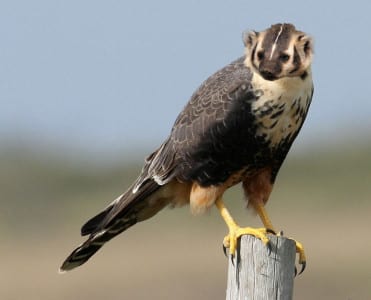
The Aplobadger Falcon is a rare bird that hunts small mammals and slow birds on many
of our North American prairies. It is normally seen immediately after the end of March,
perhaps for a day or so, and it might be a year before you see it again. Remember, these
were created by Jim Stevenmuharin, so don’t badger me about it.
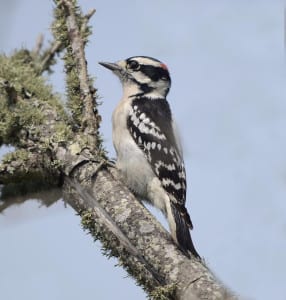
Our smallest woodpecker is the Downy, but this particular one is a very interesting bird:
It doesn’t show any banding on the white outer retrices (tail feathers). That might lead
some to think it was a Hairy, but a quick look at the short bill is enough to ID it to
Downy. The red patch on the nape designates his sex. It is extremely unlikely a Hairy (or
Red-cockaded) will ever reach our Coast.
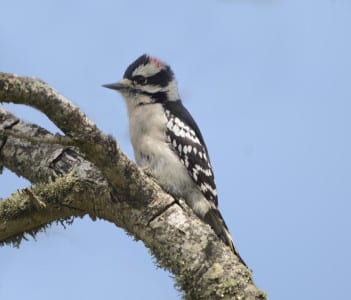
As he began noticing this tall guy with the camera fixed on him, he raised his crest like
several birds do when alarmed. Other woodpecker characteristics are the chisel bill, the
stiff tail feathers propping him up and the long toes on the previous page. These are
called zygodactyl – two toes in front and two in back.
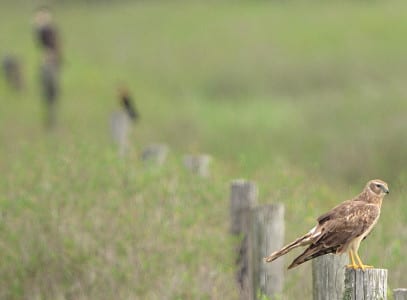
Fence posts in open areas have long since been kind to predators, as this picture shows. A
female Northern Harrier sits atop a close one, ever vigilant for rats. This species nests on
the Island, but only occasionally in the rest of Texas. A caracara waits in the back, in the
only place (Galveston) I have ever known them to eat rats. And if anyone knew the
middle bird was a female Great-tailed Grackle, you need to be running my birding tours.
![Ruby-throated Hummingbirds make up 99 point [make up a number] percent of all hummers in eastern North America, and this little lady is but one of them. You can see the absence of the gorget her future husband will have, but at least she’s taken a bath! She had quite a fun time on the drip line (akin to pole dancing?) and managed to cover all the vital spots. RTs winter in Central America and migrate up quite early in spring.](https://www.crystalbeachlocalnews.com/wp-content/uploads/2014/04/Primitive-Land-Birds-16-345x300.jpg)
Ruby-throated Hummingbirds make up 99 point [make up a number] percent of all
hummers in eastern North America, and this little lady is but one of them. You can see
the absence of the gorget her future husband will have, but at least she’s taken a bath! She
had quite a fun time on the drip line (akin to pole dancing?) and managed to cover all the
vital spots. RTs winter in Central America and migrate up quite early in spring.
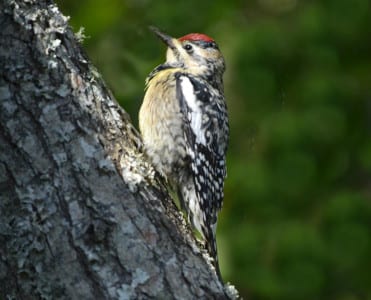
Yellow-bellied Sapsuckers are woodpeckers who feed on plant secretions and insects that
stick to it. This bird spent nearly a week in my yard – quite a long time for a migrant. The
fact that he tarried on the tree over my pond delighted me no end. You can see the typical
woodpecker characteristics (beak, feet and tail), but there are several species of closelyrelated
sapsuckers.
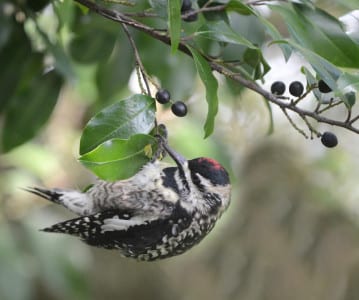
Birds like our sapsucker friend get quite adaptable in the migration as they pass through
areas of which they are unfamiliar. My little week-long pet here made a living off my
Cherry Laurel berries, as did a waxwing which spent ten days here. Most migrants are
here for only a matter of hours, so being able to study one at leisure is a treat.
And so is my yard, and all my friends, new and old.

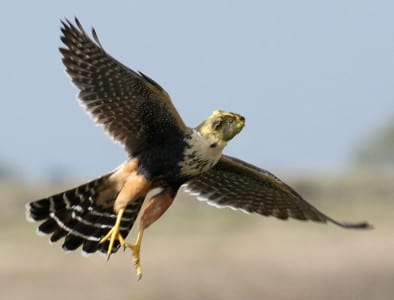
 Posted in
Posted in 
























I can’t find any more information surrounding the Aplobadger Falcon created by Jim Stevenmuharin (shown above). Granted, I only spent a few minutes looking but is anyone who’s reading this know where I can learn more? Please and Thank You.